Developmental Stages in Early Childhood: Infancy to Preschool Years
VerifiedAdded on 2020/05/16
|28
|6928
|88
AI Summary
The document outlines developmental milestones across different stages from infancy to preschool, highlighting key aspects such as physical coordination, social interaction, language acquisition, and problem-solving skills. For infants, emphasis is placed on sensory exploration and motor activities like crawling and standing. Toddlers are encouraged to engage in pretend play and simple puzzles, supporting their growing independence and communication abilities. Preschool children benefit from creative arts and structured group activities that enhance literacy and social skills. The document suggests integrating music, movement, and open-ended materials to foster creativity and cognitive development at each stage. It underscores the importance of adapting learning environments and educational content to align with the natural progression of a child's growth, advocating for an inclusive approach that caters to diverse learning needs.
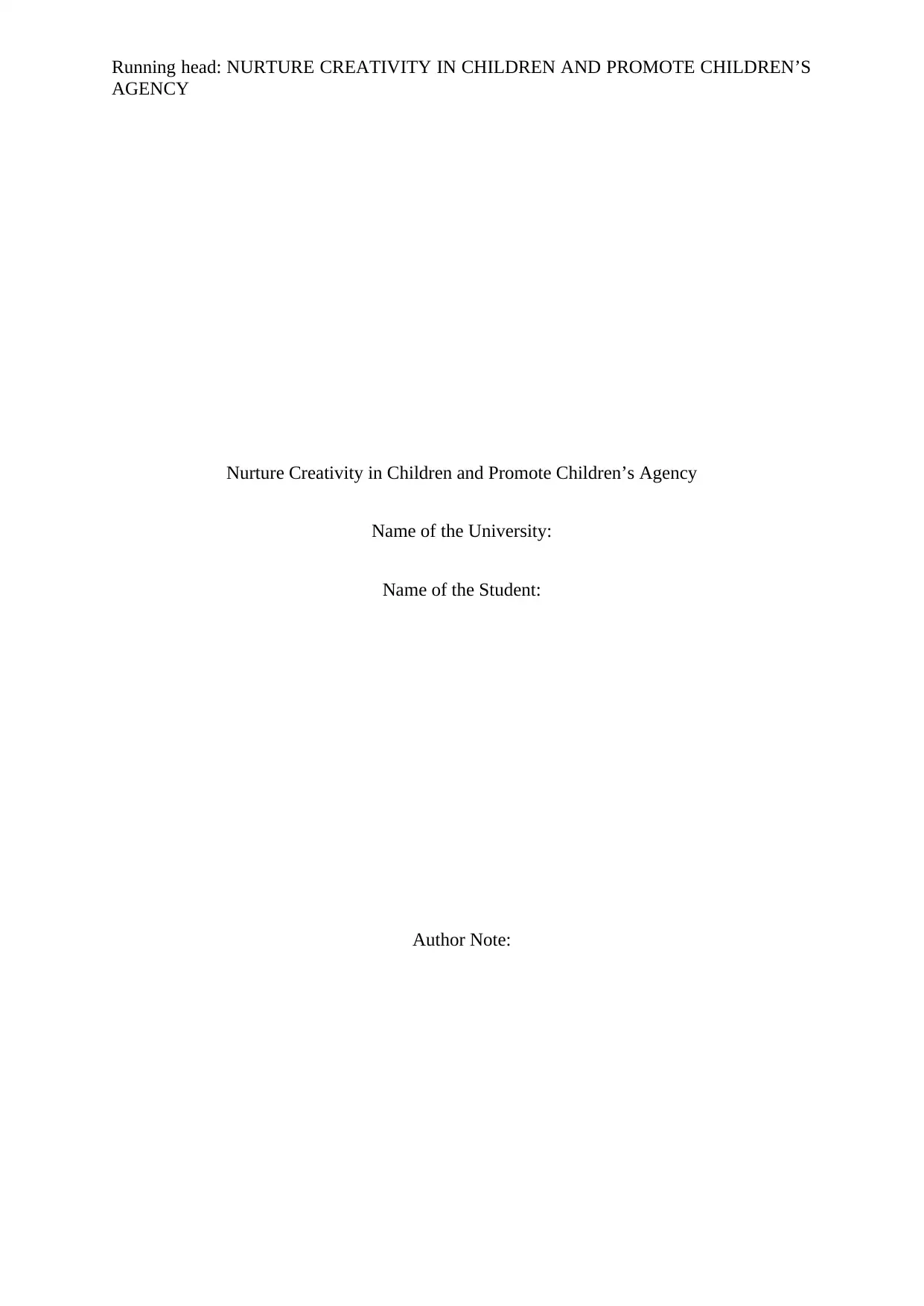
Running head: NURTURE CREATIVITY IN CHILDREN AND PROMOTE CHILDREN’S
AGENCY
Nurture Creativity in Children and Promote Children’s Agency
Name of the University:
Name of the Student:
Author Note:
AGENCY
Nurture Creativity in Children and Promote Children’s Agency
Name of the University:
Name of the Student:
Author Note:
Paraphrase This Document
Need a fresh take? Get an instant paraphrase of this document with our AI Paraphraser
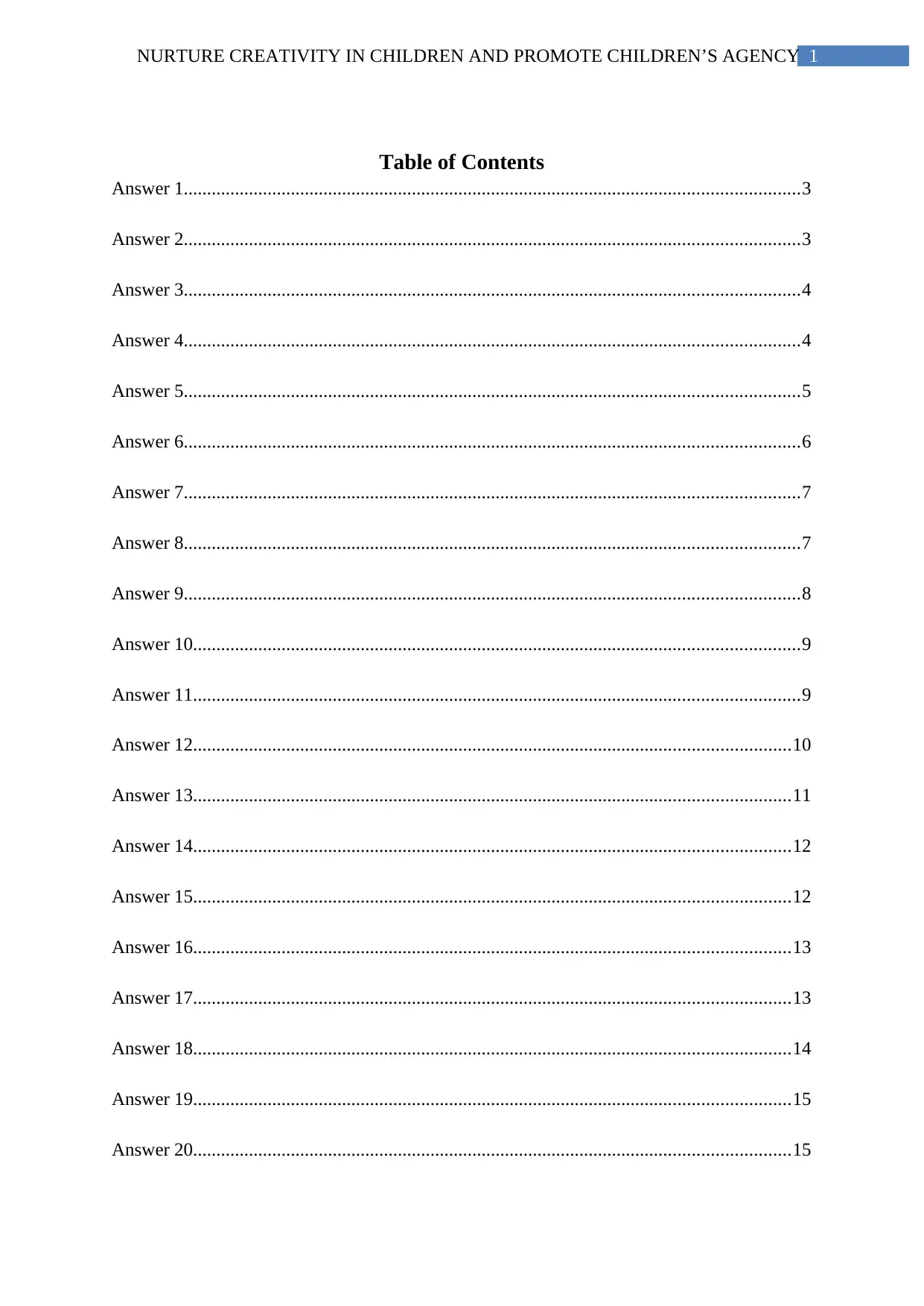
1NURTURE CREATIVITY IN CHILDREN AND PROMOTE CHILDREN’S AGENCY
Table of Contents
Answer 1....................................................................................................................................3
Answer 2....................................................................................................................................3
Answer 3....................................................................................................................................4
Answer 4....................................................................................................................................4
Answer 5....................................................................................................................................5
Answer 6....................................................................................................................................6
Answer 7....................................................................................................................................7
Answer 8....................................................................................................................................7
Answer 9....................................................................................................................................8
Answer 10..................................................................................................................................9
Answer 11..................................................................................................................................9
Answer 12................................................................................................................................10
Answer 13................................................................................................................................11
Answer 14................................................................................................................................12
Answer 15................................................................................................................................12
Answer 16................................................................................................................................13
Answer 17................................................................................................................................13
Answer 18................................................................................................................................14
Answer 19................................................................................................................................15
Answer 20................................................................................................................................15
Table of Contents
Answer 1....................................................................................................................................3
Answer 2....................................................................................................................................3
Answer 3....................................................................................................................................4
Answer 4....................................................................................................................................4
Answer 5....................................................................................................................................5
Answer 6....................................................................................................................................6
Answer 7....................................................................................................................................7
Answer 8....................................................................................................................................7
Answer 9....................................................................................................................................8
Answer 10..................................................................................................................................9
Answer 11..................................................................................................................................9
Answer 12................................................................................................................................10
Answer 13................................................................................................................................11
Answer 14................................................................................................................................12
Answer 15................................................................................................................................12
Answer 16................................................................................................................................13
Answer 17................................................................................................................................13
Answer 18................................................................................................................................14
Answer 19................................................................................................................................15
Answer 20................................................................................................................................15
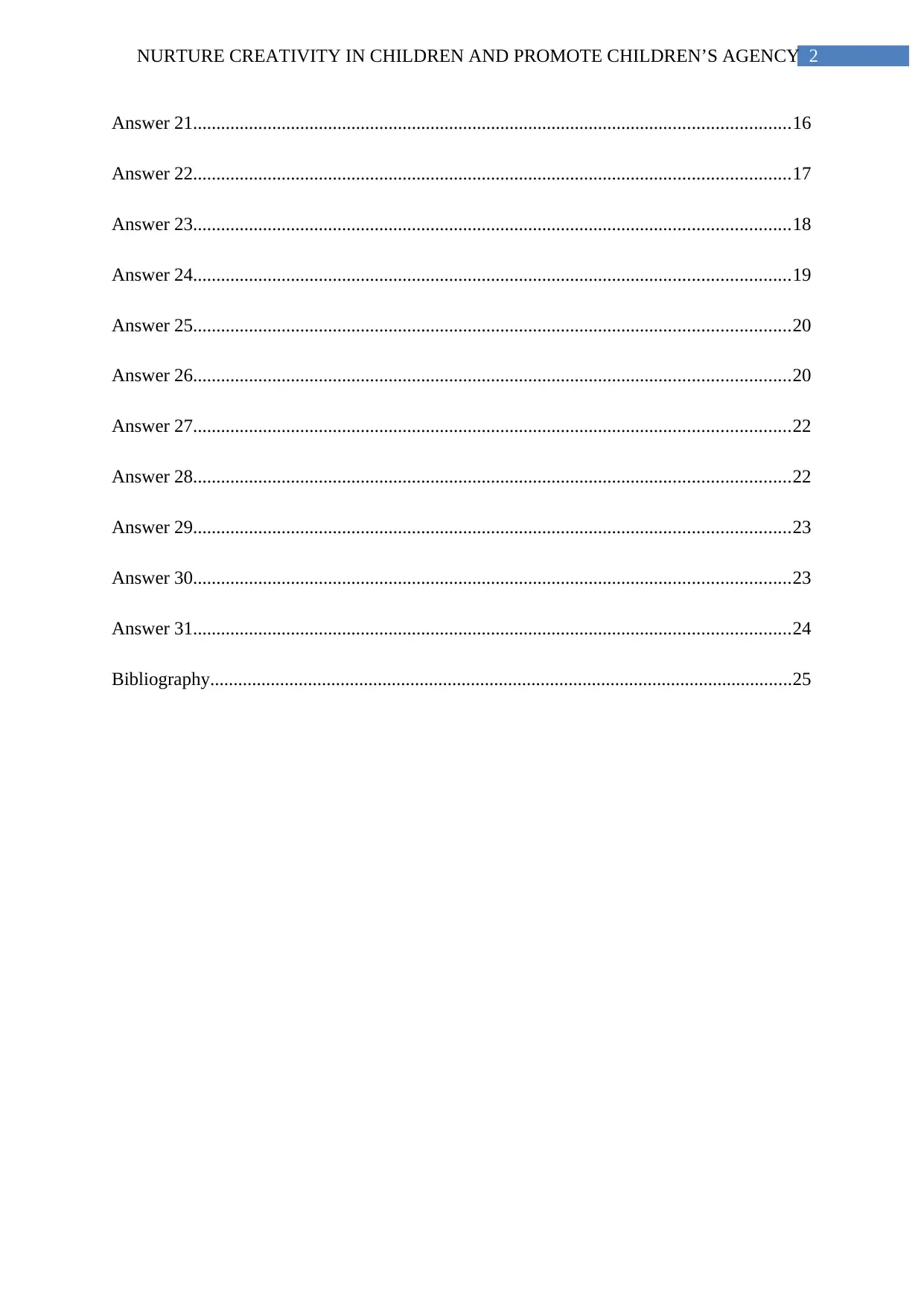
2NURTURE CREATIVITY IN CHILDREN AND PROMOTE CHILDREN’S AGENCY
Answer 21................................................................................................................................16
Answer 22................................................................................................................................17
Answer 23................................................................................................................................18
Answer 24................................................................................................................................19
Answer 25................................................................................................................................20
Answer 26................................................................................................................................20
Answer 27................................................................................................................................22
Answer 28................................................................................................................................22
Answer 29................................................................................................................................23
Answer 30................................................................................................................................23
Answer 31................................................................................................................................24
Bibliography.............................................................................................................................25
Answer 21................................................................................................................................16
Answer 22................................................................................................................................17
Answer 23................................................................................................................................18
Answer 24................................................................................................................................19
Answer 25................................................................................................................................20
Answer 26................................................................................................................................20
Answer 27................................................................................................................................22
Answer 28................................................................................................................................22
Answer 29................................................................................................................................23
Answer 30................................................................................................................................23
Answer 31................................................................................................................................24
Bibliography.............................................................................................................................25
⊘ This is a preview!⊘
Do you want full access?
Subscribe today to unlock all pages.

Trusted by 1+ million students worldwide
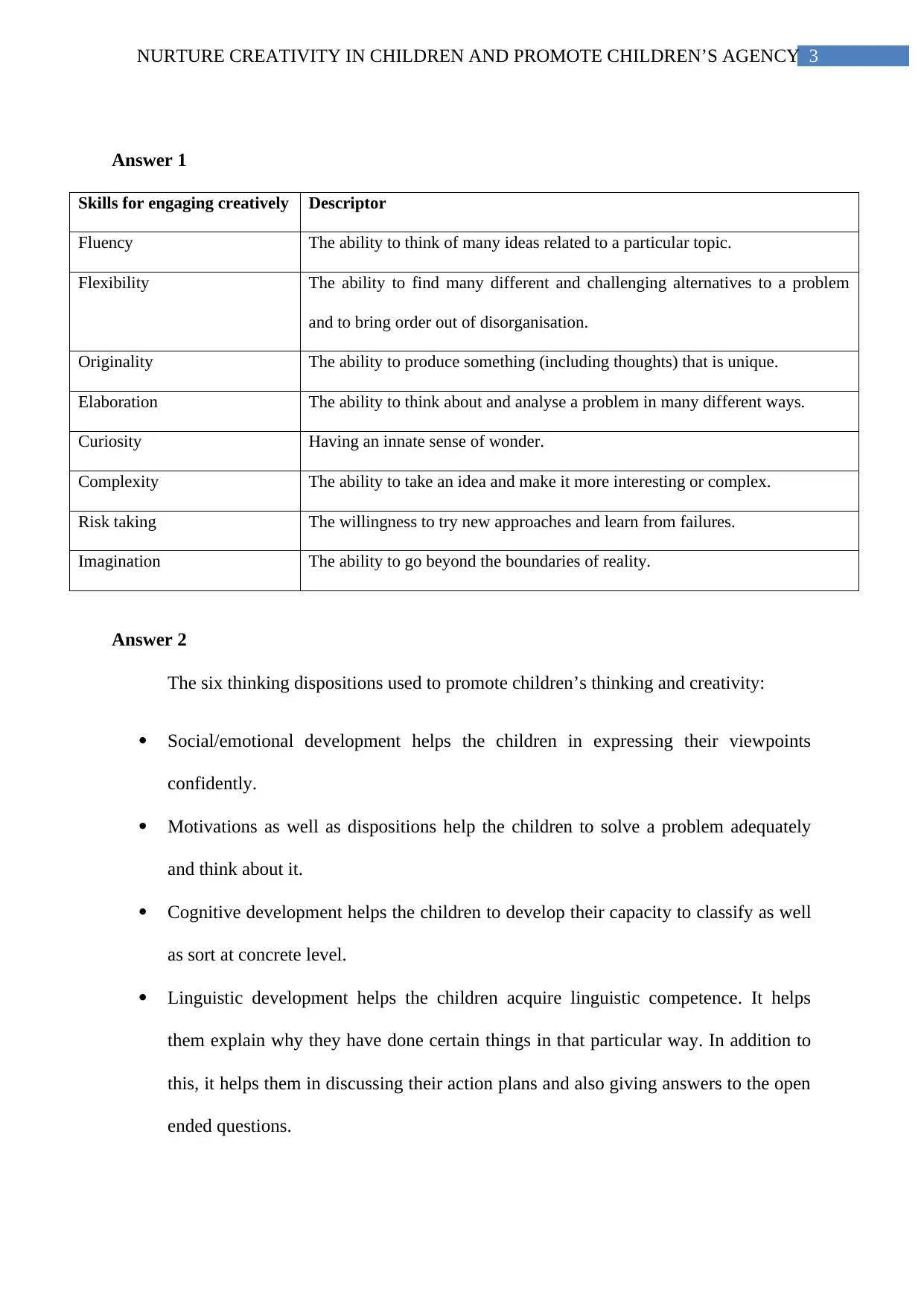
3NURTURE CREATIVITY IN CHILDREN AND PROMOTE CHILDREN’S AGENCY
Answer 1
Skills for engaging creatively Descriptor
Fluency The ability to think of many ideas related to a particular topic.
Flexibility The ability to find many different and challenging alternatives to a problem
and to bring order out of disorganisation.
Originality The ability to produce something (including thoughts) that is unique.
Elaboration The ability to think about and analyse a problem in many different ways.
Curiosity Having an innate sense of wonder.
Complexity The ability to take an idea and make it more interesting or complex.
Risk taking The willingness to try new approaches and learn from failures.
Imagination The ability to go beyond the boundaries of reality.
Answer 2
The six thinking dispositions used to promote children’s thinking and creativity:
Social/emotional development helps the children in expressing their viewpoints
confidently.
Motivations as well as dispositions help the children to solve a problem adequately
and think about it.
Cognitive development helps the children to develop their capacity to classify as well
as sort at concrete level.
Linguistic development helps the children acquire linguistic competence. It helps
them explain why they have done certain things in that particular way. In addition to
this, it helps them in discussing their action plans and also giving answers to the open
ended questions.
Answer 1
Skills for engaging creatively Descriptor
Fluency The ability to think of many ideas related to a particular topic.
Flexibility The ability to find many different and challenging alternatives to a problem
and to bring order out of disorganisation.
Originality The ability to produce something (including thoughts) that is unique.
Elaboration The ability to think about and analyse a problem in many different ways.
Curiosity Having an innate sense of wonder.
Complexity The ability to take an idea and make it more interesting or complex.
Risk taking The willingness to try new approaches and learn from failures.
Imagination The ability to go beyond the boundaries of reality.
Answer 2
The six thinking dispositions used to promote children’s thinking and creativity:
Social/emotional development helps the children in expressing their viewpoints
confidently.
Motivations as well as dispositions help the children to solve a problem adequately
and think about it.
Cognitive development helps the children to develop their capacity to classify as well
as sort at concrete level.
Linguistic development helps the children acquire linguistic competence. It helps
them explain why they have done certain things in that particular way. In addition to
this, it helps them in discussing their action plans and also giving answers to the open
ended questions.
Paraphrase This Document
Need a fresh take? Get an instant paraphrase of this document with our AI Paraphraser
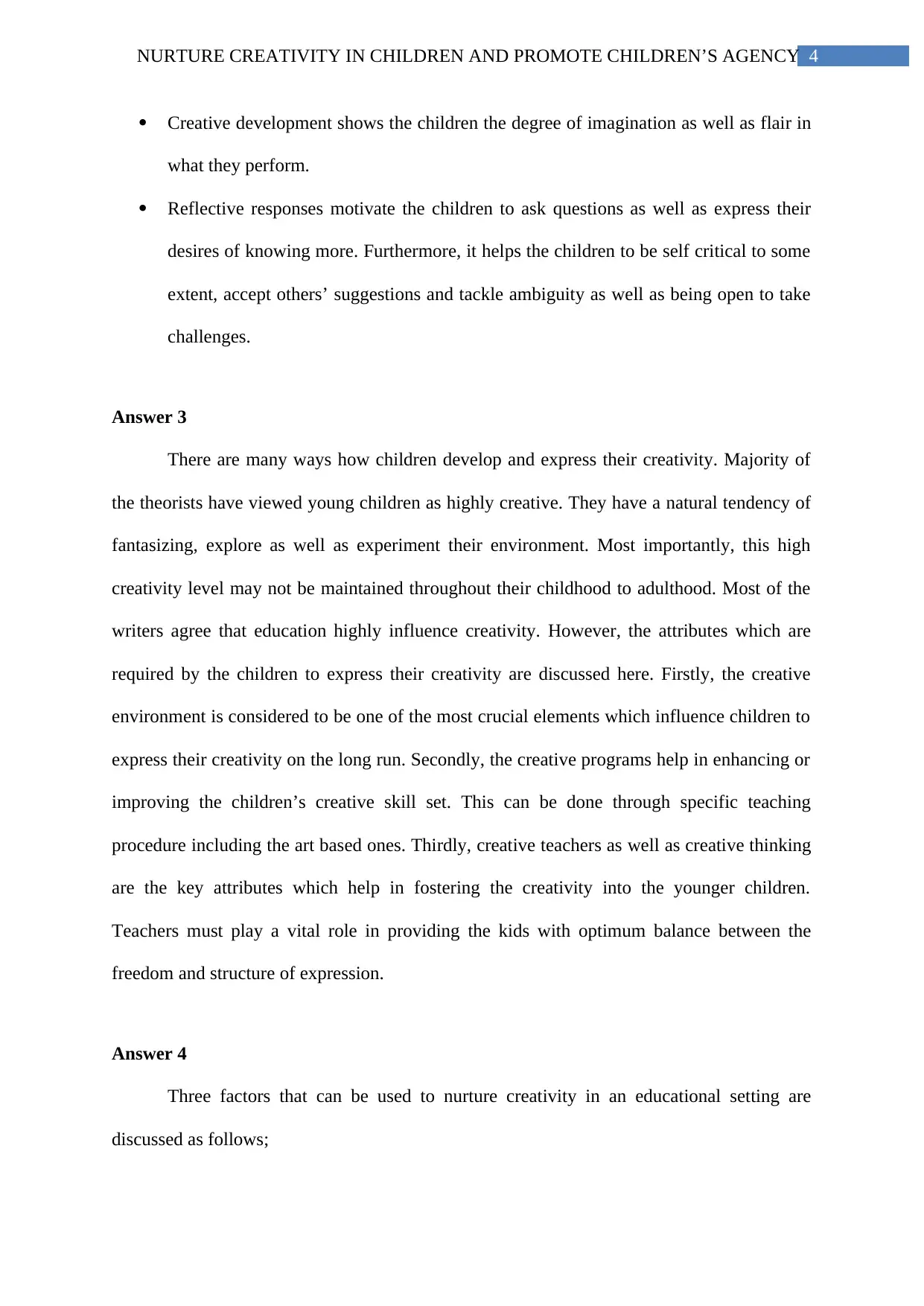
4NURTURE CREATIVITY IN CHILDREN AND PROMOTE CHILDREN’S AGENCY
Creative development shows the children the degree of imagination as well as flair in
what they perform.
Reflective responses motivate the children to ask questions as well as express their
desires of knowing more. Furthermore, it helps the children to be self critical to some
extent, accept others’ suggestions and tackle ambiguity as well as being open to take
challenges.
Answer 3
There are many ways how children develop and express their creativity. Majority of
the theorists have viewed young children as highly creative. They have a natural tendency of
fantasizing, explore as well as experiment their environment. Most importantly, this high
creativity level may not be maintained throughout their childhood to adulthood. Most of the
writers agree that education highly influence creativity. However, the attributes which are
required by the children to express their creativity are discussed here. Firstly, the creative
environment is considered to be one of the most crucial elements which influence children to
express their creativity on the long run. Secondly, the creative programs help in enhancing or
improving the children’s creative skill set. This can be done through specific teaching
procedure including the art based ones. Thirdly, creative teachers as well as creative thinking
are the key attributes which help in fostering the creativity into the younger children.
Teachers must play a vital role in providing the kids with optimum balance between the
freedom and structure of expression.
Answer 4
Three factors that can be used to nurture creativity in an educational setting are
discussed as follows;
Creative development shows the children the degree of imagination as well as flair in
what they perform.
Reflective responses motivate the children to ask questions as well as express their
desires of knowing more. Furthermore, it helps the children to be self critical to some
extent, accept others’ suggestions and tackle ambiguity as well as being open to take
challenges.
Answer 3
There are many ways how children develop and express their creativity. Majority of
the theorists have viewed young children as highly creative. They have a natural tendency of
fantasizing, explore as well as experiment their environment. Most importantly, this high
creativity level may not be maintained throughout their childhood to adulthood. Most of the
writers agree that education highly influence creativity. However, the attributes which are
required by the children to express their creativity are discussed here. Firstly, the creative
environment is considered to be one of the most crucial elements which influence children to
express their creativity on the long run. Secondly, the creative programs help in enhancing or
improving the children’s creative skill set. This can be done through specific teaching
procedure including the art based ones. Thirdly, creative teachers as well as creative thinking
are the key attributes which help in fostering the creativity into the younger children.
Teachers must play a vital role in providing the kids with optimum balance between the
freedom and structure of expression.
Answer 4
Three factors that can be used to nurture creativity in an educational setting are
discussed as follows;
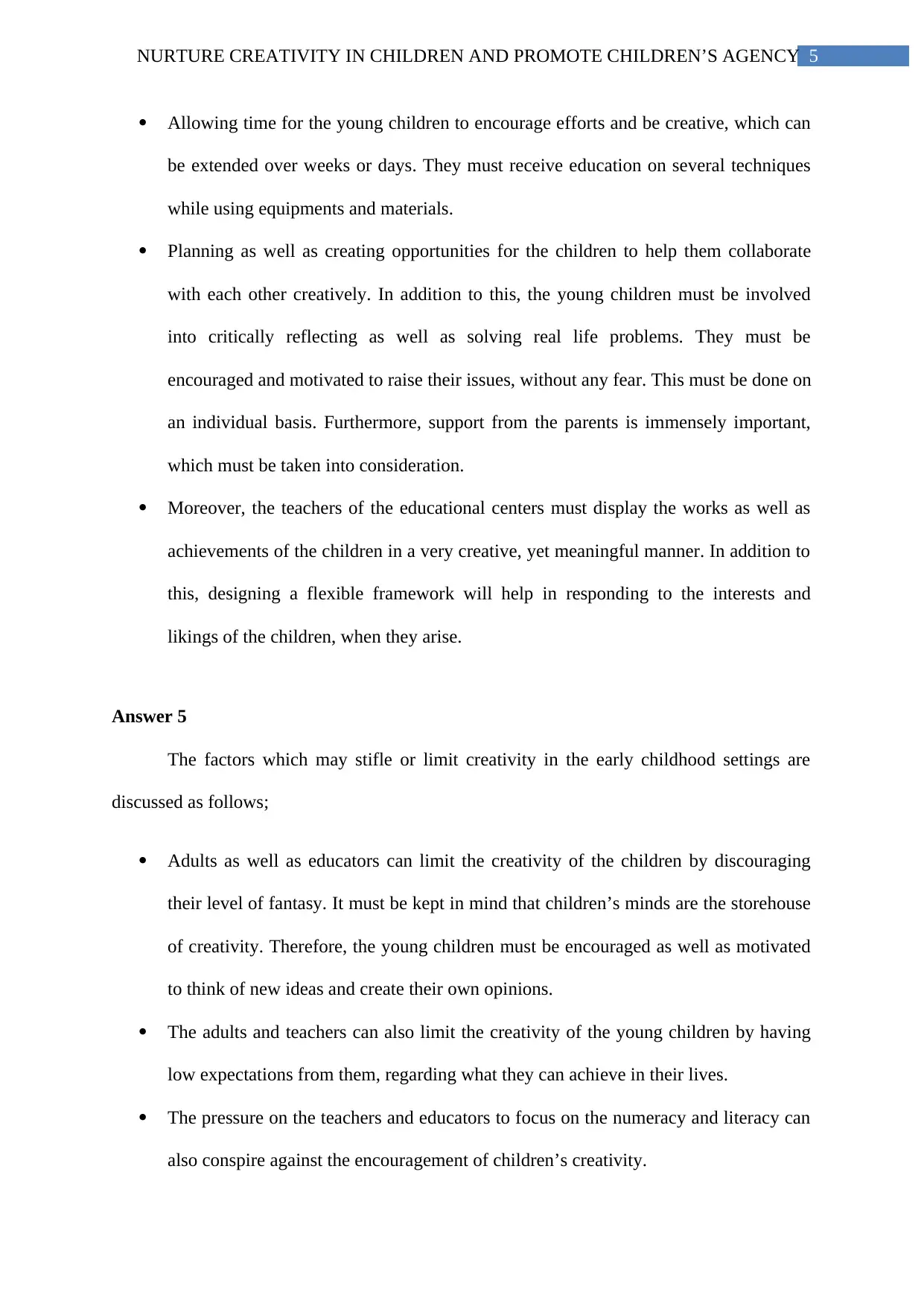
5NURTURE CREATIVITY IN CHILDREN AND PROMOTE CHILDREN’S AGENCY
Allowing time for the young children to encourage efforts and be creative, which can
be extended over weeks or days. They must receive education on several techniques
while using equipments and materials.
Planning as well as creating opportunities for the children to help them collaborate
with each other creatively. In addition to this, the young children must be involved
into critically reflecting as well as solving real life problems. They must be
encouraged and motivated to raise their issues, without any fear. This must be done on
an individual basis. Furthermore, support from the parents is immensely important,
which must be taken into consideration.
Moreover, the teachers of the educational centers must display the works as well as
achievements of the children in a very creative, yet meaningful manner. In addition to
this, designing a flexible framework will help in responding to the interests and
likings of the children, when they arise.
Answer 5
The factors which may stifle or limit creativity in the early childhood settings are
discussed as follows;
Adults as well as educators can limit the creativity of the children by discouraging
their level of fantasy. It must be kept in mind that children’s minds are the storehouse
of creativity. Therefore, the young children must be encouraged as well as motivated
to think of new ideas and create their own opinions.
The adults and teachers can also limit the creativity of the young children by having
low expectations from them, regarding what they can achieve in their lives.
The pressure on the teachers and educators to focus on the numeracy and literacy can
also conspire against the encouragement of children’s creativity.
Allowing time for the young children to encourage efforts and be creative, which can
be extended over weeks or days. They must receive education on several techniques
while using equipments and materials.
Planning as well as creating opportunities for the children to help them collaborate
with each other creatively. In addition to this, the young children must be involved
into critically reflecting as well as solving real life problems. They must be
encouraged and motivated to raise their issues, without any fear. This must be done on
an individual basis. Furthermore, support from the parents is immensely important,
which must be taken into consideration.
Moreover, the teachers of the educational centers must display the works as well as
achievements of the children in a very creative, yet meaningful manner. In addition to
this, designing a flexible framework will help in responding to the interests and
likings of the children, when they arise.
Answer 5
The factors which may stifle or limit creativity in the early childhood settings are
discussed as follows;
Adults as well as educators can limit the creativity of the children by discouraging
their level of fantasy. It must be kept in mind that children’s minds are the storehouse
of creativity. Therefore, the young children must be encouraged as well as motivated
to think of new ideas and create their own opinions.
The adults and teachers can also limit the creativity of the young children by having
low expectations from them, regarding what they can achieve in their lives.
The pressure on the teachers and educators to focus on the numeracy and literacy can
also conspire against the encouragement of children’s creativity.
⊘ This is a preview!⊘
Do you want full access?
Subscribe today to unlock all pages.

Trusted by 1+ million students worldwide
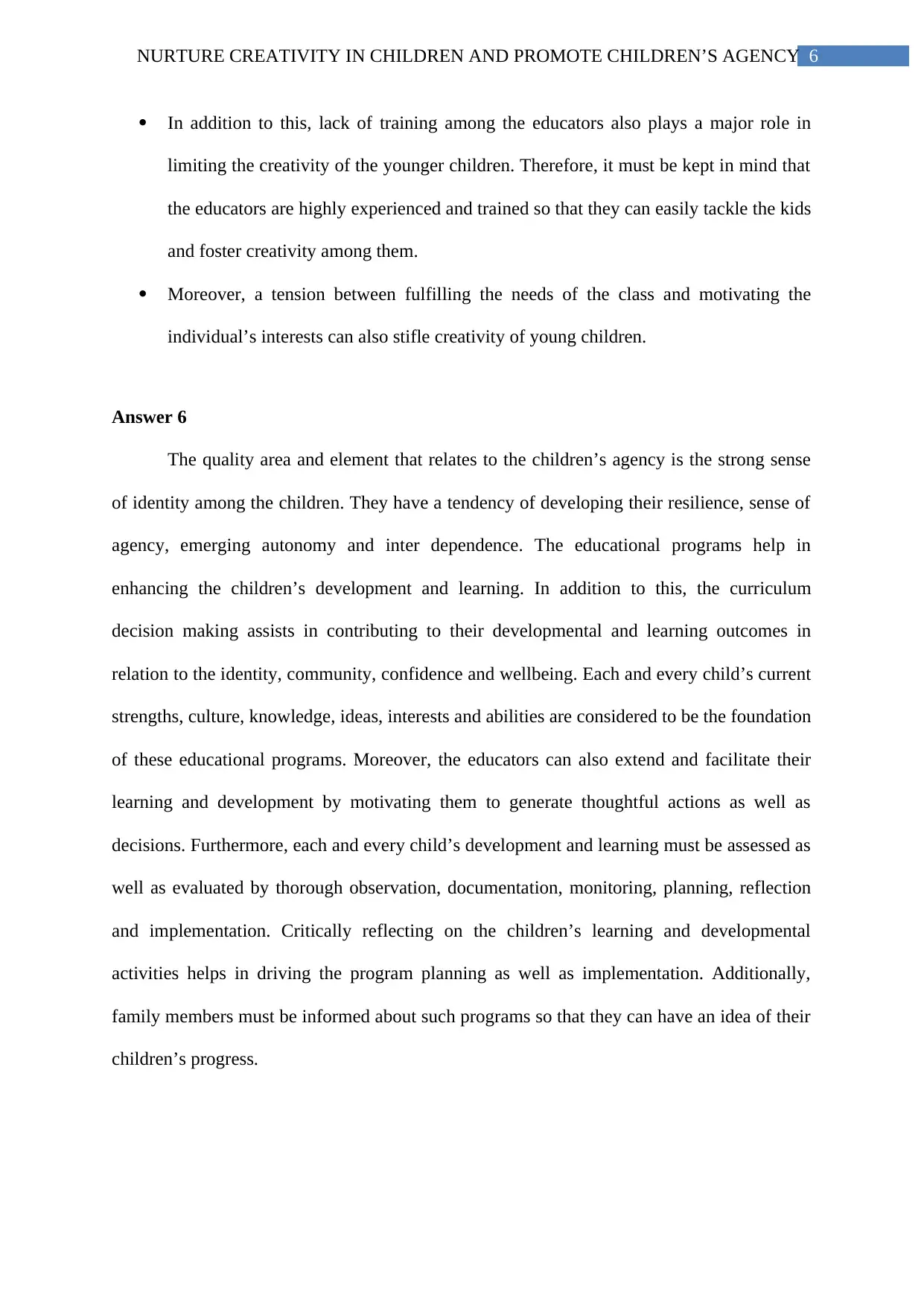
6NURTURE CREATIVITY IN CHILDREN AND PROMOTE CHILDREN’S AGENCY
In addition to this, lack of training among the educators also plays a major role in
limiting the creativity of the younger children. Therefore, it must be kept in mind that
the educators are highly experienced and trained so that they can easily tackle the kids
and foster creativity among them.
Moreover, a tension between fulfilling the needs of the class and motivating the
individual’s interests can also stifle creativity of young children.
Answer 6
The quality area and element that relates to the children’s agency is the strong sense
of identity among the children. They have a tendency of developing their resilience, sense of
agency, emerging autonomy and inter dependence. The educational programs help in
enhancing the children’s development and learning. In addition to this, the curriculum
decision making assists in contributing to their developmental and learning outcomes in
relation to the identity, community, confidence and wellbeing. Each and every child’s current
strengths, culture, knowledge, ideas, interests and abilities are considered to be the foundation
of these educational programs. Moreover, the educators can also extend and facilitate their
learning and development by motivating them to generate thoughtful actions as well as
decisions. Furthermore, each and every child’s development and learning must be assessed as
well as evaluated by thorough observation, documentation, monitoring, planning, reflection
and implementation. Critically reflecting on the children’s learning and developmental
activities helps in driving the program planning as well as implementation. Additionally,
family members must be informed about such programs so that they can have an idea of their
children’s progress.
In addition to this, lack of training among the educators also plays a major role in
limiting the creativity of the younger children. Therefore, it must be kept in mind that
the educators are highly experienced and trained so that they can easily tackle the kids
and foster creativity among them.
Moreover, a tension between fulfilling the needs of the class and motivating the
individual’s interests can also stifle creativity of young children.
Answer 6
The quality area and element that relates to the children’s agency is the strong sense
of identity among the children. They have a tendency of developing their resilience, sense of
agency, emerging autonomy and inter dependence. The educational programs help in
enhancing the children’s development and learning. In addition to this, the curriculum
decision making assists in contributing to their developmental and learning outcomes in
relation to the identity, community, confidence and wellbeing. Each and every child’s current
strengths, culture, knowledge, ideas, interests and abilities are considered to be the foundation
of these educational programs. Moreover, the educators can also extend and facilitate their
learning and development by motivating them to generate thoughtful actions as well as
decisions. Furthermore, each and every child’s development and learning must be assessed as
well as evaluated by thorough observation, documentation, monitoring, planning, reflection
and implementation. Critically reflecting on the children’s learning and developmental
activities helps in driving the program planning as well as implementation. Additionally,
family members must be informed about such programs so that they can have an idea of their
children’s progress.
Paraphrase This Document
Need a fresh take? Get an instant paraphrase of this document with our AI Paraphraser
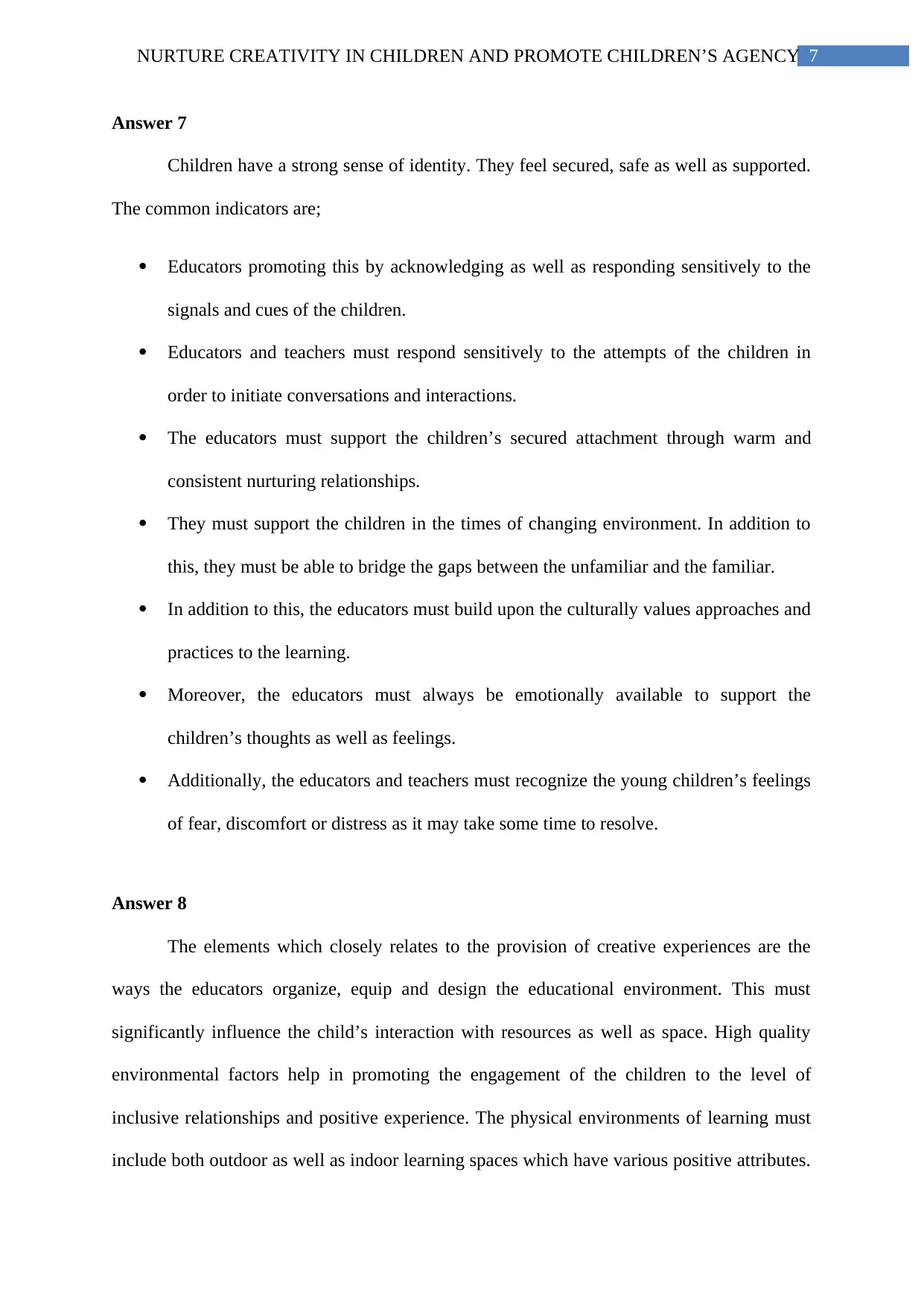
7NURTURE CREATIVITY IN CHILDREN AND PROMOTE CHILDREN’S AGENCY
Answer 7
Children have a strong sense of identity. They feel secured, safe as well as supported.
The common indicators are;
Educators promoting this by acknowledging as well as responding sensitively to the
signals and cues of the children.
Educators and teachers must respond sensitively to the attempts of the children in
order to initiate conversations and interactions.
The educators must support the children’s secured attachment through warm and
consistent nurturing relationships.
They must support the children in the times of changing environment. In addition to
this, they must be able to bridge the gaps between the unfamiliar and the familiar.
In addition to this, the educators must build upon the culturally values approaches and
practices to the learning.
Moreover, the educators must always be emotionally available to support the
children’s thoughts as well as feelings.
Additionally, the educators and teachers must recognize the young children’s feelings
of fear, discomfort or distress as it may take some time to resolve.
Answer 8
The elements which closely relates to the provision of creative experiences are the
ways the educators organize, equip and design the educational environment. This must
significantly influence the child’s interaction with resources as well as space. High quality
environmental factors help in promoting the engagement of the children to the level of
inclusive relationships and positive experience. The physical environments of learning must
include both outdoor as well as indoor learning spaces which have various positive attributes.
Answer 7
Children have a strong sense of identity. They feel secured, safe as well as supported.
The common indicators are;
Educators promoting this by acknowledging as well as responding sensitively to the
signals and cues of the children.
Educators and teachers must respond sensitively to the attempts of the children in
order to initiate conversations and interactions.
The educators must support the children’s secured attachment through warm and
consistent nurturing relationships.
They must support the children in the times of changing environment. In addition to
this, they must be able to bridge the gaps between the unfamiliar and the familiar.
In addition to this, the educators must build upon the culturally values approaches and
practices to the learning.
Moreover, the educators must always be emotionally available to support the
children’s thoughts as well as feelings.
Additionally, the educators and teachers must recognize the young children’s feelings
of fear, discomfort or distress as it may take some time to resolve.
Answer 8
The elements which closely relates to the provision of creative experiences are the
ways the educators organize, equip and design the educational environment. This must
significantly influence the child’s interaction with resources as well as space. High quality
environmental factors help in promoting the engagement of the children to the level of
inclusive relationships and positive experience. The physical environments of learning must
include both outdoor as well as indoor learning spaces which have various positive attributes.
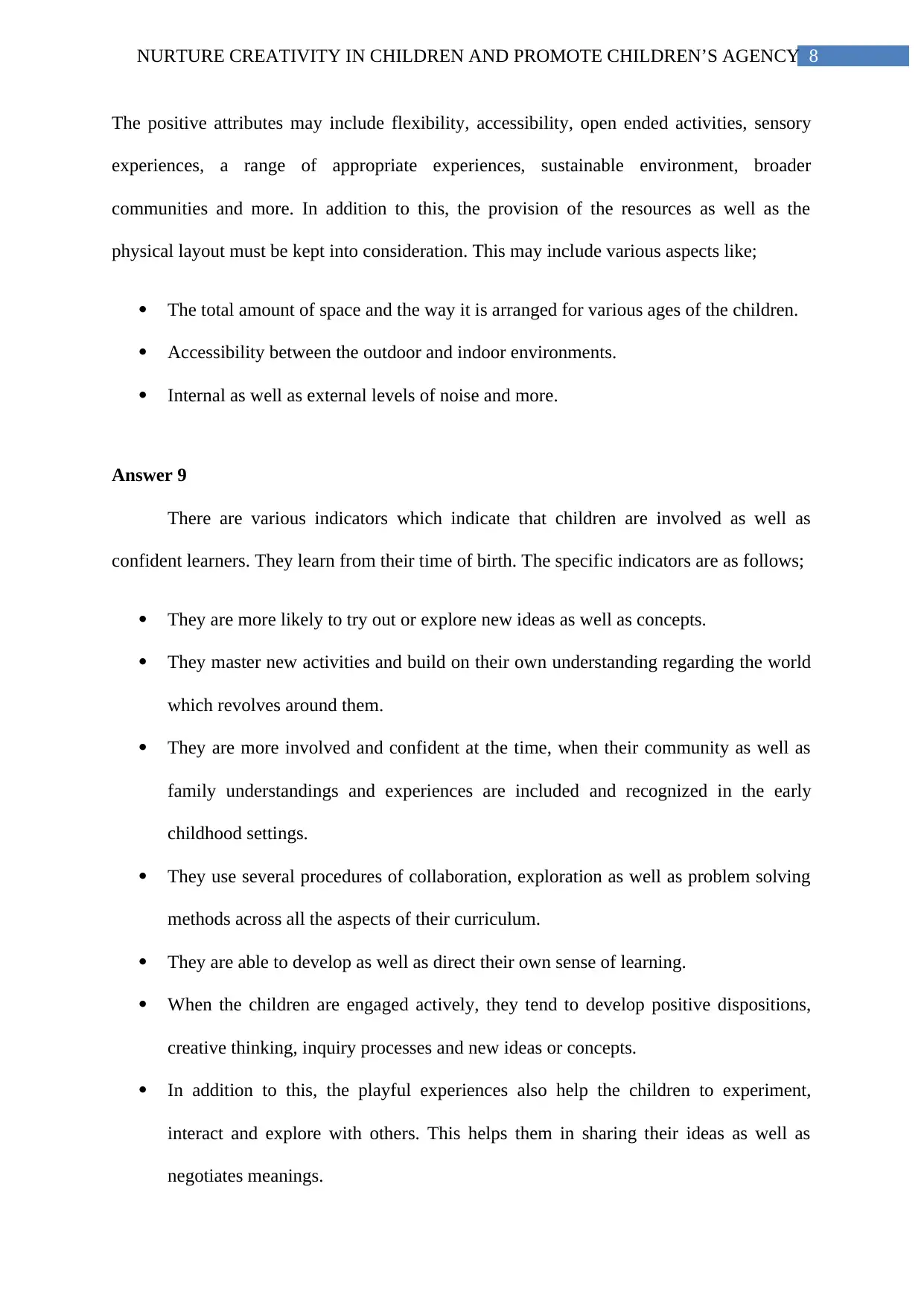
8NURTURE CREATIVITY IN CHILDREN AND PROMOTE CHILDREN’S AGENCY
The positive attributes may include flexibility, accessibility, open ended activities, sensory
experiences, a range of appropriate experiences, sustainable environment, broader
communities and more. In addition to this, the provision of the resources as well as the
physical layout must be kept into consideration. This may include various aspects like;
The total amount of space and the way it is arranged for various ages of the children.
Accessibility between the outdoor and indoor environments.
Internal as well as external levels of noise and more.
Answer 9
There are various indicators which indicate that children are involved as well as
confident learners. They learn from their time of birth. The specific indicators are as follows;
They are more likely to try out or explore new ideas as well as concepts.
They master new activities and build on their own understanding regarding the world
which revolves around them.
They are more involved and confident at the time, when their community as well as
family understandings and experiences are included and recognized in the early
childhood settings.
They use several procedures of collaboration, exploration as well as problem solving
methods across all the aspects of their curriculum.
They are able to develop as well as direct their own sense of learning.
When the children are engaged actively, they tend to develop positive dispositions,
creative thinking, inquiry processes and new ideas or concepts.
In addition to this, the playful experiences also help the children to experiment,
interact and explore with others. This helps them in sharing their ideas as well as
negotiates meanings.
The positive attributes may include flexibility, accessibility, open ended activities, sensory
experiences, a range of appropriate experiences, sustainable environment, broader
communities and more. In addition to this, the provision of the resources as well as the
physical layout must be kept into consideration. This may include various aspects like;
The total amount of space and the way it is arranged for various ages of the children.
Accessibility between the outdoor and indoor environments.
Internal as well as external levels of noise and more.
Answer 9
There are various indicators which indicate that children are involved as well as
confident learners. They learn from their time of birth. The specific indicators are as follows;
They are more likely to try out or explore new ideas as well as concepts.
They master new activities and build on their own understanding regarding the world
which revolves around them.
They are more involved and confident at the time, when their community as well as
family understandings and experiences are included and recognized in the early
childhood settings.
They use several procedures of collaboration, exploration as well as problem solving
methods across all the aspects of their curriculum.
They are able to develop as well as direct their own sense of learning.
When the children are engaged actively, they tend to develop positive dispositions,
creative thinking, inquiry processes and new ideas or concepts.
In addition to this, the playful experiences also help the children to experiment,
interact and explore with others. This helps them in sharing their ideas as well as
negotiates meanings.
⊘ This is a preview!⊘
Do you want full access?
Subscribe today to unlock all pages.

Trusted by 1+ million students worldwide
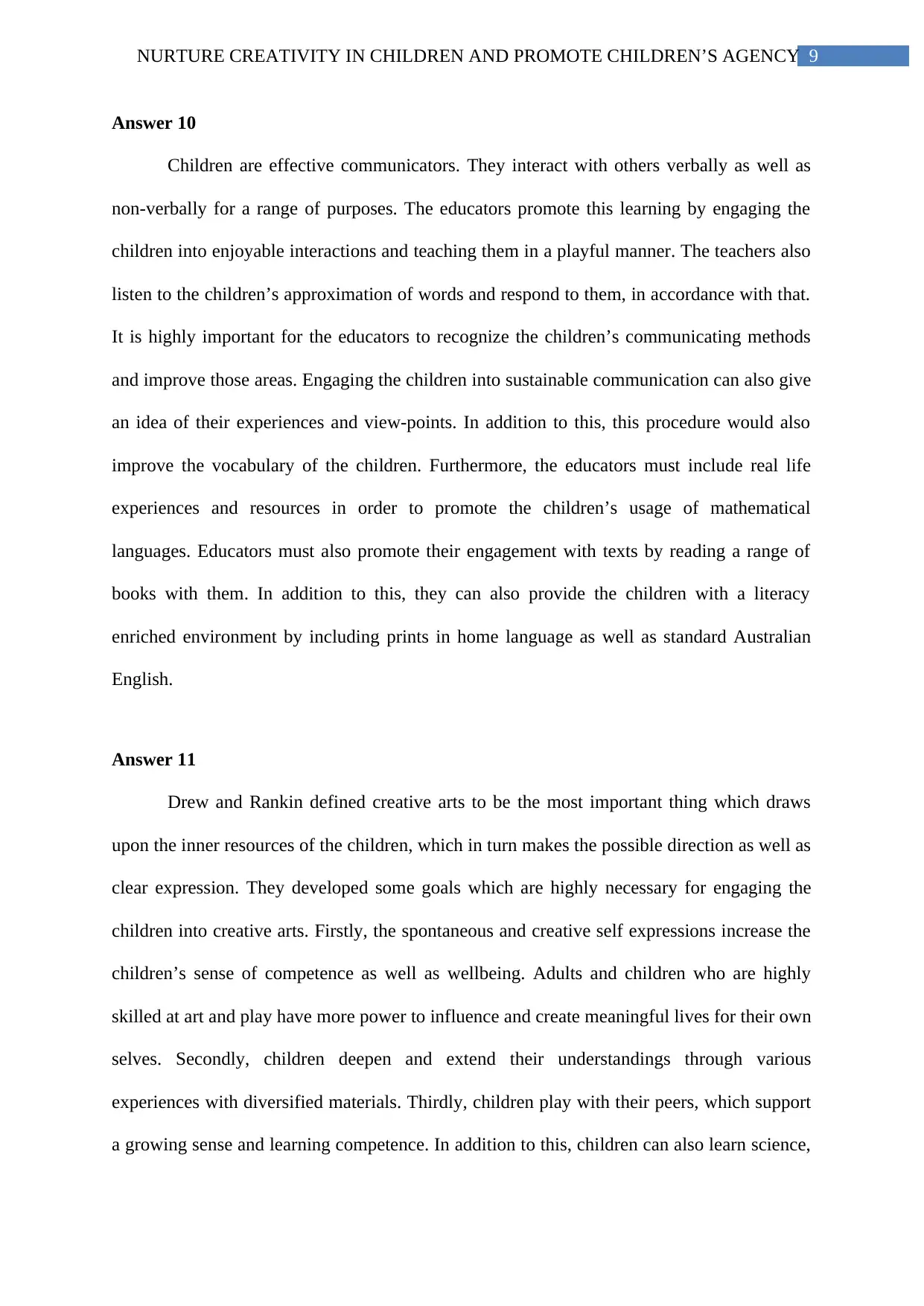
9NURTURE CREATIVITY IN CHILDREN AND PROMOTE CHILDREN’S AGENCY
Answer 10
Children are effective communicators. They interact with others verbally as well as
non-verbally for a range of purposes. The educators promote this learning by engaging the
children into enjoyable interactions and teaching them in a playful manner. The teachers also
listen to the children’s approximation of words and respond to them, in accordance with that.
It is highly important for the educators to recognize the children’s communicating methods
and improve those areas. Engaging the children into sustainable communication can also give
an idea of their experiences and view-points. In addition to this, this procedure would also
improve the vocabulary of the children. Furthermore, the educators must include real life
experiences and resources in order to promote the children’s usage of mathematical
languages. Educators must also promote their engagement with texts by reading a range of
books with them. In addition to this, they can also provide the children with a literacy
enriched environment by including prints in home language as well as standard Australian
English.
Answer 11
Drew and Rankin defined creative arts to be the most important thing which draws
upon the inner resources of the children, which in turn makes the possible direction as well as
clear expression. They developed some goals which are highly necessary for engaging the
children into creative arts. Firstly, the spontaneous and creative self expressions increase the
children’s sense of competence as well as wellbeing. Adults and children who are highly
skilled at art and play have more power to influence and create meaningful lives for their own
selves. Secondly, children deepen and extend their understandings through various
experiences with diversified materials. Thirdly, children play with their peers, which support
a growing sense and learning competence. In addition to this, children can also learn science,
Answer 10
Children are effective communicators. They interact with others verbally as well as
non-verbally for a range of purposes. The educators promote this learning by engaging the
children into enjoyable interactions and teaching them in a playful manner. The teachers also
listen to the children’s approximation of words and respond to them, in accordance with that.
It is highly important for the educators to recognize the children’s communicating methods
and improve those areas. Engaging the children into sustainable communication can also give
an idea of their experiences and view-points. In addition to this, this procedure would also
improve the vocabulary of the children. Furthermore, the educators must include real life
experiences and resources in order to promote the children’s usage of mathematical
languages. Educators must also promote their engagement with texts by reading a range of
books with them. In addition to this, they can also provide the children with a literacy
enriched environment by including prints in home language as well as standard Australian
English.
Answer 11
Drew and Rankin defined creative arts to be the most important thing which draws
upon the inner resources of the children, which in turn makes the possible direction as well as
clear expression. They developed some goals which are highly necessary for engaging the
children into creative arts. Firstly, the spontaneous and creative self expressions increase the
children’s sense of competence as well as wellbeing. Adults and children who are highly
skilled at art and play have more power to influence and create meaningful lives for their own
selves. Secondly, children deepen and extend their understandings through various
experiences with diversified materials. Thirdly, children play with their peers, which support
a growing sense and learning competence. In addition to this, children can also learn science,
Paraphrase This Document
Need a fresh take? Get an instant paraphrase of this document with our AI Paraphraser
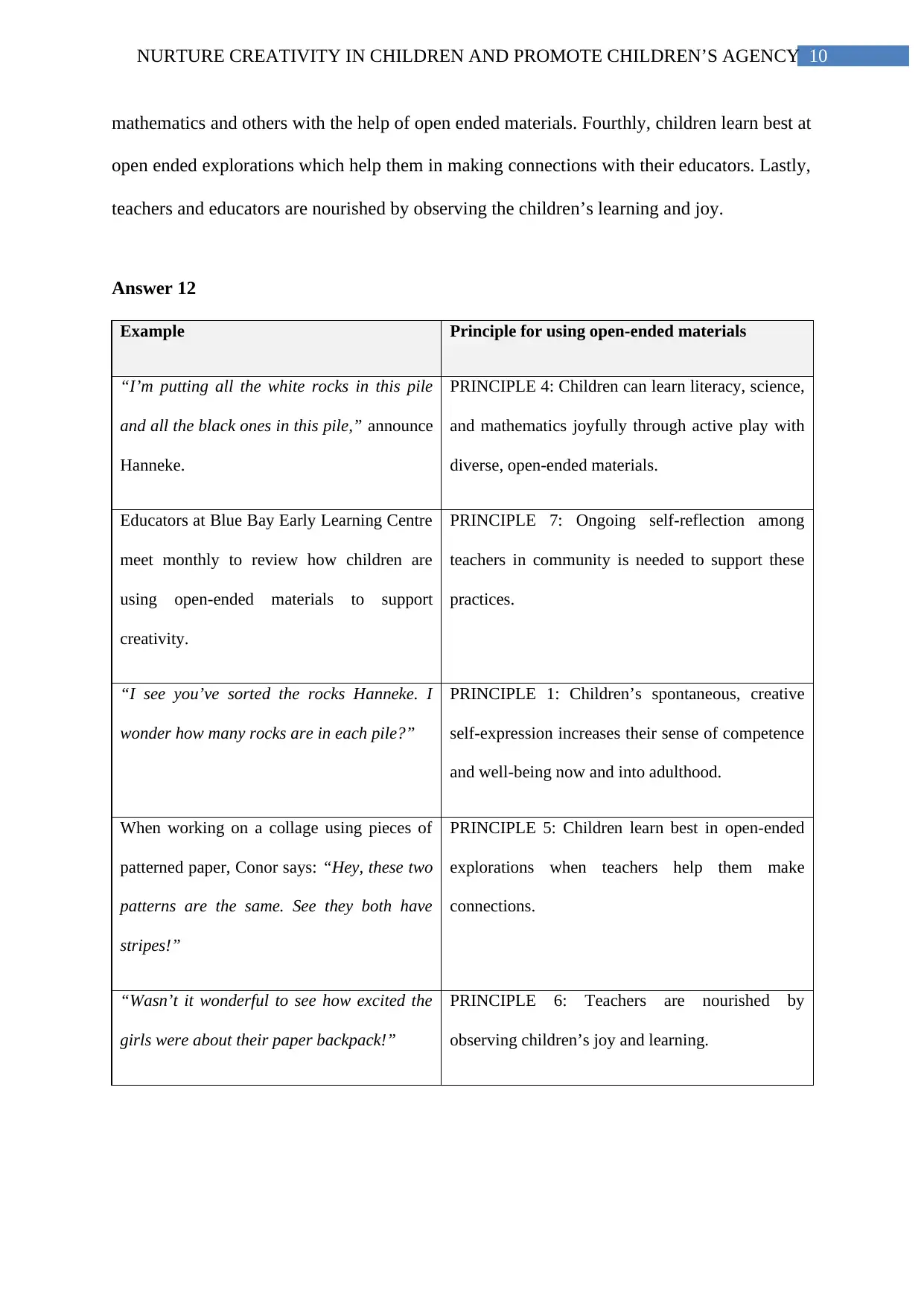
10NURTURE CREATIVITY IN CHILDREN AND PROMOTE CHILDREN’S AGENCY
mathematics and others with the help of open ended materials. Fourthly, children learn best at
open ended explorations which help them in making connections with their educators. Lastly,
teachers and educators are nourished by observing the children’s learning and joy.
Answer 12
Example Principle for using open-ended materials
“I’m putting all the white rocks in this pile
and all the black ones in this pile,” announce
Hanneke.
PRINCIPLE 4: Children can learn literacy, science,
and mathematics joyfully through active play with
diverse, open-ended materials.
Educators at Blue Bay Early Learning Centre
meet monthly to review how children are
using open-ended materials to support
creativity.
PRINCIPLE 7: Ongoing self-reflection among
teachers in community is needed to support these
practices.
“I see you’ve sorted the rocks Hanneke. I
wonder how many rocks are in each pile?”
PRINCIPLE 1: Children’s spontaneous, creative
self-expression increases their sense of competence
and well-being now and into adulthood.
When working on a collage using pieces of
patterned paper, Conor says: “Hey, these two
patterns are the same. See they both have
stripes!”
PRINCIPLE 5: Children learn best in open-ended
explorations when teachers help them make
connections.
“Wasn’t it wonderful to see how excited the
girls were about their paper backpack!”
PRINCIPLE 6: Teachers are nourished by
observing children’s joy and learning.
mathematics and others with the help of open ended materials. Fourthly, children learn best at
open ended explorations which help them in making connections with their educators. Lastly,
teachers and educators are nourished by observing the children’s learning and joy.
Answer 12
Example Principle for using open-ended materials
“I’m putting all the white rocks in this pile
and all the black ones in this pile,” announce
Hanneke.
PRINCIPLE 4: Children can learn literacy, science,
and mathematics joyfully through active play with
diverse, open-ended materials.
Educators at Blue Bay Early Learning Centre
meet monthly to review how children are
using open-ended materials to support
creativity.
PRINCIPLE 7: Ongoing self-reflection among
teachers in community is needed to support these
practices.
“I see you’ve sorted the rocks Hanneke. I
wonder how many rocks are in each pile?”
PRINCIPLE 1: Children’s spontaneous, creative
self-expression increases their sense of competence
and well-being now and into adulthood.
When working on a collage using pieces of
patterned paper, Conor says: “Hey, these two
patterns are the same. See they both have
stripes!”
PRINCIPLE 5: Children learn best in open-ended
explorations when teachers help them make
connections.
“Wasn’t it wonderful to see how excited the
girls were about their paper backpack!”
PRINCIPLE 6: Teachers are nourished by
observing children’s joy and learning.
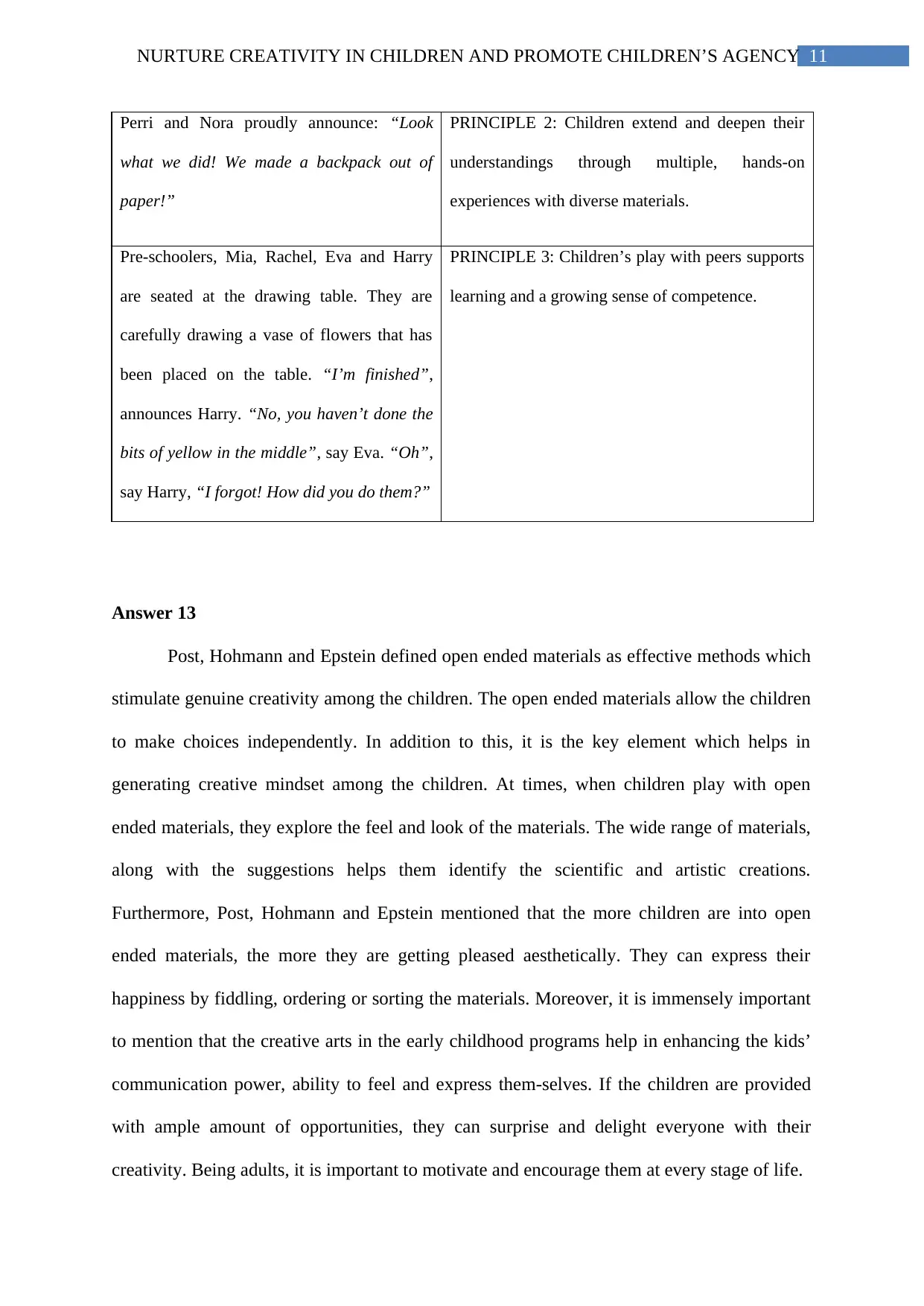
11NURTURE CREATIVITY IN CHILDREN AND PROMOTE CHILDREN’S AGENCY
Perri and Nora proudly announce: “Look
what we did! We made a backpack out of
paper!”
PRINCIPLE 2: Children extend and deepen their
understandings through multiple, hands-on
experiences with diverse materials.
Pre-schoolers, Mia, Rachel, Eva and Harry
are seated at the drawing table. They are
carefully drawing a vase of flowers that has
been placed on the table. “I’m finished”,
announces Harry. “No, you haven’t done the
bits of yellow in the middle”, say Eva. “Oh”,
say Harry, “I forgot! How did you do them?”
PRINCIPLE 3: Children’s play with peers supports
learning and a growing sense of competence.
Answer 13
Post, Hohmann and Epstein defined open ended materials as effective methods which
stimulate genuine creativity among the children. The open ended materials allow the children
to make choices independently. In addition to this, it is the key element which helps in
generating creative mindset among the children. At times, when children play with open
ended materials, they explore the feel and look of the materials. The wide range of materials,
along with the suggestions helps them identify the scientific and artistic creations.
Furthermore, Post, Hohmann and Epstein mentioned that the more children are into open
ended materials, the more they are getting pleased aesthetically. They can express their
happiness by fiddling, ordering or sorting the materials. Moreover, it is immensely important
to mention that the creative arts in the early childhood programs help in enhancing the kids’
communication power, ability to feel and express them-selves. If the children are provided
with ample amount of opportunities, they can surprise and delight everyone with their
creativity. Being adults, it is important to motivate and encourage them at every stage of life.
Perri and Nora proudly announce: “Look
what we did! We made a backpack out of
paper!”
PRINCIPLE 2: Children extend and deepen their
understandings through multiple, hands-on
experiences with diverse materials.
Pre-schoolers, Mia, Rachel, Eva and Harry
are seated at the drawing table. They are
carefully drawing a vase of flowers that has
been placed on the table. “I’m finished”,
announces Harry. “No, you haven’t done the
bits of yellow in the middle”, say Eva. “Oh”,
say Harry, “I forgot! How did you do them?”
PRINCIPLE 3: Children’s play with peers supports
learning and a growing sense of competence.
Answer 13
Post, Hohmann and Epstein defined open ended materials as effective methods which
stimulate genuine creativity among the children. The open ended materials allow the children
to make choices independently. In addition to this, it is the key element which helps in
generating creative mindset among the children. At times, when children play with open
ended materials, they explore the feel and look of the materials. The wide range of materials,
along with the suggestions helps them identify the scientific and artistic creations.
Furthermore, Post, Hohmann and Epstein mentioned that the more children are into open
ended materials, the more they are getting pleased aesthetically. They can express their
happiness by fiddling, ordering or sorting the materials. Moreover, it is immensely important
to mention that the creative arts in the early childhood programs help in enhancing the kids’
communication power, ability to feel and express them-selves. If the children are provided
with ample amount of opportunities, they can surprise and delight everyone with their
creativity. Being adults, it is important to motivate and encourage them at every stage of life.
⊘ This is a preview!⊘
Do you want full access?
Subscribe today to unlock all pages.

Trusted by 1+ million students worldwide
1 out of 28
Related Documents
Your All-in-One AI-Powered Toolkit for Academic Success.
+13062052269
info@desklib.com
Available 24*7 on WhatsApp / Email
![[object Object]](/_next/static/media/star-bottom.7253800d.svg)
Unlock your academic potential
Copyright © 2020–2025 A2Z Services. All Rights Reserved. Developed and managed by ZUCOL.




